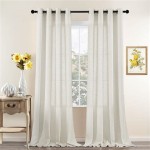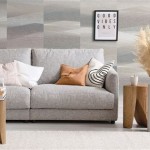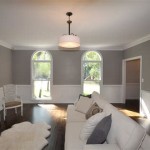Living Room Blinds For Large Windows: Functionality and Aesthetics
Large windows in a living room offer numerous benefits, including increased natural light, expansive views, and a connection to the outdoors. However, these large openings also present unique challenges when it comes to window treatments. Blinds, when chosen carefully, can be an excellent solution, offering both functional control over light and privacy, as well as contributing significantly to the overall aesthetic of the living space. Selecting the appropriate type of blinds for large windows requires careful consideration of factors such as window size, room decor, desired level of light control, and budget.
The sheer size of large windows dictates that the chosen blinds must be durable and easy to operate. Mechanisms need to be robust enough to handle the weight and dimensions of the blinds without straining or breaking. Furthermore, the aesthetic impact of the blinds is amplified by the larger surface area they cover. Therefore, the style, color, and material of the blinds should complement the existing interior design to create a cohesive and visually appealing environment.
Considerations for Material Selection
The material of the blinds is a crucial factor affecting both their functionality and appearance. Common materials for living room blinds include wood, faux wood, aluminum, and fabric. Each material possesses distinct characteristics that influence its suitability for large windows.
Wood blinds offer a classic and elegant look, adding warmth and natural texture to the living room. They are relatively durable and provide excellent light control. However, real wood blinds can be expensive and may require more maintenance than other options. They are also susceptible to warping in humid environments, making them less suitable for bathrooms or kitchens. For large windows, lighter wood types may be preferred to reduce the overall weight on the operating mechanism.
Faux wood blinds are a more affordable and practical alternative to real wood. They mimic the appearance of wood but are made from composite materials like PVC or vinyl. Faux wood blinds are resistant to moisture, warping, and cracking, making them ideal for areas with high humidity or temperature fluctuations. They are also easier to clean and maintain than real wood blinds. Their durability and cost-effectiveness make them a popular choice for large living room windows.
Aluminum blinds are a lightweight and durable option, known for their sleek and modern aesthetic. They are available in a wide range of colors and finishes, making them versatile for various design styles. Aluminum blinds are particularly effective at reflecting heat, which can help to reduce energy costs in the summer months. However, they can be noisy when adjusted due to the metal-on-metal contact. For large windows, heavier gauge aluminum blinds are recommended for increased durability and resistance to bending.
Fabric blinds, such as roller shades or Roman shades, offer a softer and more textured look compared to wood or metal blinds. They come in a variety of fabrics, colors, and patterns, allowing for greater design flexibility. Fabric blinds can also provide varying degrees of light control, from sheer fabrics that filter light to blackout fabrics that completely block it out. However, fabric blinds may require more frequent cleaning than other types, and some fabrics may be prone to fading in direct sunlight. For large windows, motorized fabric blinds can be a convenient option, especially for hard-to-reach areas.
Evaluating Different Blind Styles for Large Windows
Beyond the material, the style of the blinds significantly impacts their functionality and aesthetic appeal. Several blind styles are well-suited for large windows, each offering unique features and benefits.
Horizontal blinds, also known as Venetian blinds, consist of horizontal slats that can be tilted to control the amount of light entering the room. They are a versatile and classic choice that works well with various architectural styles. Horizontal blinds are available in different materials, including wood, faux wood, and aluminum. For large windows, wider slats are often preferred as they offer a cleaner and more contemporary look. The ease of light adjustment offered by Venetian blinds makes them suitable for living rooms where varying degrees of sunlight are desired throughout the day.
Vertical blinds feature vertical slats that can be rotated or drawn to the side. They are particularly well-suited for large windows and sliding glass doors. Vertical blinds offer excellent light control and privacy, as the slats can be adjusted to any angle. They are available in various materials, including fabric, vinyl, and aluminum. Fabric vertical blinds can add a touch of softness and texture to the room, while vinyl and aluminum blinds are more durable and easier to clean. Due to their construction, vertical blinds are often the most practical for very wide window spans.
Roller shades are a simple and streamlined option consisting of a single piece of fabric that rolls up or down. They are available in a wide range of fabrics, colors, and patterns, allowing for great design flexibility. Roller shades can provide varying degrees of light control, from sheer to blackout. For large windows, motorized roller shades are a convenient option, especially for hard-to-reach areas or for homeowners seeking enhanced control. Dual roller shades, which combine two different fabrics (e.g., a sheer and a blackout fabric) in a single system, offer even greater versatility.
Roman shades are a more decorative option, consisting of fabric that folds into horizontal pleats when raised. They add a touch of elegance and sophistication to the room. Roman shades are available in various fabrics, colors, and patterns. However, they may require more fabric than other types of blinds, making them a more expensive option for large windows. Flat Roman shades offer a clean and contemporary look, while looped Roman shades add a more traditional and luxurious feel. Their decorative nature makes Roman shades a good choice for living rooms where aesthetics are a primary concern.
Operational and Technological Considerations
The method of operating the blinds is a critical element, especially with the added weight and dimensions associated with large windows. Manual operation, while typically more affordable, can become cumbersome for large blinds. Motorized blinds offer a convenient and user-friendly solution, allowing for effortless control with the touch of a button or through smart home integration.
Manual operation of large blinds often involves cords or wands. The quality and durability of these mechanisms are crucial for ensuring smooth and reliable operation over time. Cords should be made of strong, non-fraying materials, and wands should be sturdy and easy to grip. The lifting mechanism should be designed to handle the weight of the blinds without straining or breaking. Consider the placement of cords, especially in households with young children or pets, to address safety concerns.
Motorized blinds offer several advantages, including convenience, enhanced safety, and improved energy efficiency. They can be operated with a remote control, wall switch, or smartphone app. Motorized blinds can also be integrated with smart home systems, allowing for automated control based on time of day, weather conditions, or other factors. For large windows, motorized blinds are particularly beneficial as they eliminate the need to manually lift or lower heavy blinds. They also offer a cleaner look, as there are no cords or wands to clutter the window area. The cost of motorized blinds is typically higher than manual blinds, but the added convenience and functionality may justify the investment for many homeowners.
Smart home integration allows for even greater control and customization of motorized blinds. Through a smart home system, blinds can be programmed to automatically open and close at specific times, or in response to changes in light levels or temperature. This can help to reduce energy costs by maximizing natural light and ventilation while minimizing heat gain or loss. Smart home integration also allows for remote control of the blinds, enabling homeowners to adjust them from anywhere with an internet connection. This can be particularly useful for vacation homes or for homeowners who want to control their blinds while they are away from home.
In conclusion, selecting the right blinds for large living room windows involves a careful balancing act between functional requirements and aesthetic preferences. The material, style, and operational method should all be considered in light of the specific needs and design goals of the living space. By carefully considering these factors, homeowners can choose blinds that provide optimal light control, privacy, and energy efficiency while enhancing the overall beauty and comfort of their living room.

Blinds For Large Windows Hunter Douglas One Stop Decorating

The Best Blinds For Large Windows

Modern Living Room Window Treatments Blinds To Go

Floor To Ceiling Blinds Window Treatments For Large Windows

Window Treatments Large Windows Austin Floor To Ceiling

Blinds For Larger Windows Swift Direct

Advice On Covering Large Windows At Home Blinds Decor

Window Treatments For Large Windows Blinds

Window Treatments Large Windows San Antonio Floor To Ceiling

Best Blinds For Large Windows And Doors U Blog








